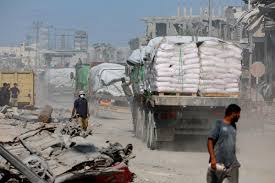Gaza City — Hopes for lasting peace in Gaza dimmed on Tuesday as Israel restricted humanitarian aid and delayed reopening border crossings, while Hamas fighters reasserted control in parts of the enclave, publicly executing suspected collaborators amid a fragile ceasefire.
Israeli officials said only 300 aid trucks — half the previously agreed number — would be allowed to enter Gaza daily starting Wednesday. No fuel or gas will be permitted, except for limited humanitarian purposes, according to a diplomatic note seen by Reuters and confirmed by the United Nations.
The move follows Israel’s claim that Hamas had been “uncooperative” in handing over the remains of Israeli hostages, a central component of Phase Two of U.S. President Donald Trump’s ceasefire plan.
“The dead have not been returned, as promised! Phase Two begins right NOW!” Trump wrote on Truth Social, signaling frustration with the stalled process.
Following a partial Israeli military withdrawal last week, Hamas fighters have resurfaced in several urban districts. Videos circulating on social media showed masked gunmen executing seven men accused of collaborating with Israel in a Gaza City square.
Reuters verified the footage and confirmed that Hamas militants were present. A senior Hamas source later said the executions were intended to “restore order” and deter criminal activity, though human rights observers condemned the killings as extrajudicial.
Despite heavy losses from two years of intense Israeli bombardment, Hamas has quickly moved to fill the security vacuum, deploying fighters to oversee aid routes and workers to clear rubble from major roads.
“Hamas is asserting its grip again — not as strong as before, but strong enough to shape the next phase of this ceasefire,” said Omar al-Hassan, a political analyst in Ramallah.
The ceasefire, brokered with U.S. and Egyptian mediation, initially involved a large-scale prisoner exchange: the release of the final 20 Israeli hostages in exchange for nearly 2,000 Palestinian detainees.
However, Hamas has so far delivered only four bodies of deceased Israeli hostages, with at least 23 still unaccounted for. Israeli officials accused Hamas of deliberately stalling, while Hamas said many bodies were buried under the rubble of Israeli airstrikes.
An Egyptian official involved in the negotiations told Reuters that Hamas had agreed to transfer four more bodies by Tuesday evening, but “deep mistrust remains on both sides.”
Meanwhile, aid distribution inside Gaza remains chaotic. The U.N. Relief and Works Agency (UNRWA) warned that fuel shortages have crippled hospital operations and clean water systems. “Every delay costs lives,” a spokesperson said.
Trump’s ambitious “New Middle East” plan — which envisions an international stabilization force and a post-war governance structure for Gaza — faces mounting skepticism. A summit co-hosted by the U.S. and Egypt on Monday ended without concrete progress.
Israeli Prime Minister Benjamin Netanyahu reiterated that “the war cannot truly end” until Hamas is completely disarmed and removed from governance — a condition Hamas has firmly rejected.
Palestinian Authority officials in the West Bank called for an international peacekeeping mission to take temporary control of Gaza, but Western diplomats privately acknowledge little appetite for deployment amid ongoing instability.
Two years of relentless warfare have devastated Gaza. According to local health authorities, Israel’s military campaign has killed nearly 68,000 Palestinians, while thousands remain buried under rubble.
The October 2023 Hamas-led attacks that triggered the war killed around 1,200 Israelis and took 251 hostages, according to Israeli data.
Swathes of Gaza are now uninhabitable. The World Food Programme and global hunger monitors declared a famine in parts of the enclave in August, warning that “a total collapse of basic life systems” could occur without immediate aid access.
Residents returning to what remains of their homes describe entire neighborhoods reduced to dust. “We hoped the ceasefire would bring life,” said Rania Shabat, a mother of three in Khan Younis. “But every day feels like we are starting over in ruins.”
As both sides trade accusations of violating the ceasefire, and with U.S. mediation losing momentum, prospects for a permanent peace remain bleak.
“Hamas wants to prove it survived. Israel wants to prove it won. And ordinary Gazans are caught between both,” said a U.N. diplomat in Jerusalem.
For now, the ceasefire holds — but just barely.



